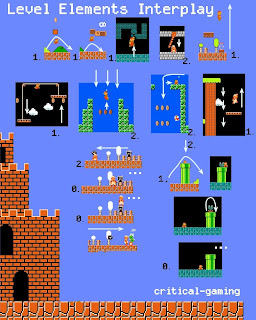Mario Melodies: Interplay part.2
 Wednesday, June 18, 2008 at 12:02AM
Wednesday, June 18, 2008 at 12:02AM We've already outlined interplay thoroughly in part 1. Now it's time to look at the interplay in Super Mario Brothers in detail. Keep in mind that interplay works best when it encourages the use of a game's primary mechanic in a variety of ways. In Super Mario Brothers, the order of mechanics are as follows:
- 0. Idle position (doing nothing)
- 1. Jump
- 2. Run, Duck, Slide, Swim, Throw fireball
- 3. Starman powerup, Koopa shell attacks
- Bricks: can harden, break, or be bumped continuously. In all cases, Mario rebounds back downward quickly and at a sharp angle restricting upward and horizontal control.
- Fire Bar: can be ducked if there is a small gap between the fire ball and the floor.
- Spring: can launch Mario very high or very short with a well timed jump.
- Pulley Platforms: move under Mario's weight according to a simple pulley system.
- Water Current: can pull Mario downward or across. It's an invisible force that Mario must struggle against by repeatedly swimming.
- Falling Platform: This platform only falls when Mario is standing on it.
- Bullet Bill: At a certain distance away from the cannon, Bullet Bills will fire. Once Mario is close enough, nothing will be fired. The Bullet Bill can also travel through solid parts of a stage keeping up with Mario throughout a level.
- Pipes: Mario can enter some pipes. Some pipes contain Piranha Flowers that emerge when Mario is a certain distance away like the Bullet Bill. When Mario is close, nothing comes out.
As a simple minded fungus, the Goomba travels slowly in one direction. When a Goomba comes across a wall or other non hostile solid object, it simply reverses direction. Overcoming a Gooma is as simple as waiting for them to walk themselves to their doom, jumping over them, jumping on them, hitting a brick they're standing on from underneath, throwing a fireball, or kicking a koopa shell at them. But don't be fooled.
Depending on a variety of factors, Goombas can become a deceptively effective enemy. Fireballs can bounce over their heads. If you're big Mario attacking Goombas from underneath, the bricks can break creating an opportunity for the next Goomba to land right on top of you. And if you think you can squish the first Goomba and relax, the next Goomba in line can reverse direction off of the squished remains. These level 2 interplay designs make the Goomba a formidable enemy depending on their numbers and level position.

And if you think the Koopas are another simple enemy, consider that the Para-Koopa can reach up to the 7th level of interplay.
- De-wing the Para-Koopa by jumping on it
- The Koopa will fall to one side and walk in Mario's direction upon landing.
- Green Koopas generally walk themselves to their doom unlike Red Koopas who turn around on the edges of platforms. In order to attack the Koopa, it must be jumped on or bumped from underneath. Unlike the Goomba, there is no way to kill a Koopa by just jumping on it or bumping it.
- Once the Koopa has been attacked, it'll rest in its shell. But after approximately 5.5 seconds, it'll wake back up. What's even trickier is, depending on the Koopa, upon waking, it'll head in Mario's direction even if it wasn't moving in Mario direction before.
- To prevent the Koopa from getting back up, it can be kicked away while still inside its shell. This is also useful as an attack against other enemies.
- If the shell hits a solid level element, it'll bounce back toward Mario. This sliding shell poses a threat.
- To avoid getting hurt, there are only a few courses of action. One can always simply jump over the shell. However, to counter it directly, Mario can stop the shell from moving by jumping on top of it, or kick another shell into it for a double KO. If Mario stops the shell, then the cycle resets back to level 5. If it ever wakes up again, the cycle resets back to level 3.
Though there are many more enemies to cover, for now we'll stop with these two classics. Hopefully, I demonstrated how to break down and diagram interplay based on gameplay mechanics. The next topic of discussion is variation, or how small changes can affect gameplay in a big way. Stay tuned.



